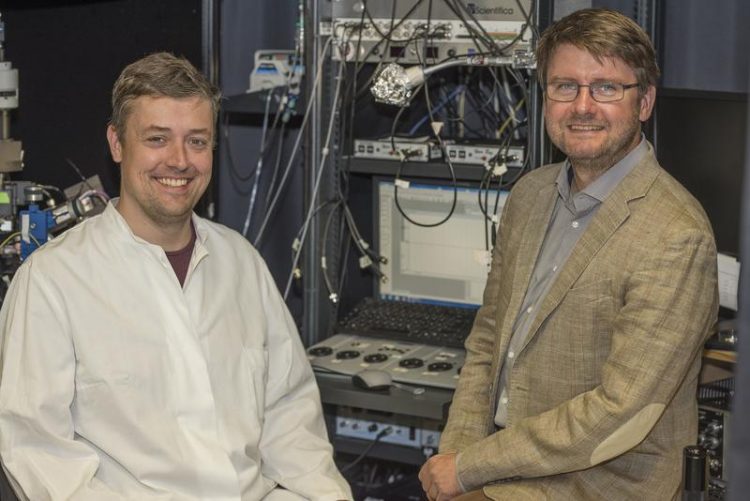Study tracks inner workings of the brain with new biosensor

Biosensor for neurotransmitter glycine: Professor Christian Henneberger (r) and his college from Bonn, Dr. Daniel Minge (l) use a microscope to observe brain tissue at work © Rolf Müller / UK Bonn
The research team has, for the first time, optically tracked the movements of the neurotransmitter glycine, which is a signalling molecule in the brain, with a new biosensor.
Associate Professor Colin Jackson from The Australian National University (ANU) said the new study would help scientists gain more insight into many neurological diseases that occur due to dysfunctional neurotransmitter activity.
“To understand how the brain works at the molecular level and how things can go wrong, we need to understand the release and uptake of neurotransmitters,” said Associate Professor Jackson from the ANU Research School of Chemistry.
“Neurotransmitters are too small to see directly, so we made a new biosensor for them.”
The research team designed and made a protein to bind glycine and fused it with two other proteins that are fluorescent.
Glycine is a neurotransmitter in the central nervous system, including in the cortex, spinal cord, brainstem and retina, that plays a role in neuronal communication and learning, and also in processing motor and sensory information that permits movement, vision and hearing.
“When the binding protein binds to glycine, the fluorescent proteins change their relative positions and we see a change in fluoresce that we can monitor with a special microscope,” Associate Professor Jackson said.
“There was previously no way to visualise the activity of glycine in brain tissue – we can do this now, which is exciting.
“In the future, we want to make sensors for other neurotransmitters and to use our sensor to look at the molecular basis of certain neurological diseases.”
The research was funded by the Human Frontiers in Science Fellowship Program, which funded Associate Professor Jackson’s team at ANU and researchers at the University of Bonn in Germany and the Institute of Science and Technology in Austria.
Professor Christian Henneberger’s team at the University of Bonn in Germany assisted in design of the sensor and developed the techniques to use the new biosensor in living brain tissue. This enabled them to see how glycine levels change in real time in response to neuronal activity and how glycine is distributed in living brain tissue.
“The sensor allowed us to directly test important hypotheses about glycine signalling. We also discovered that, unexpectedly, glycine levels change during neuronal activity that induces learning-related synaptic changes,” Professor Henneberger said.
“We are following up our study by further exploring the mechanisms that govern glycine’s influence on information processing in the healthy brain and also in disease models.”
The study will be published in the journal Nature Chemical Biology in September and is already available online:
Publication: William H. Zhang, Michel K. Herde, Joshua A. Mitchell, Jason H. Whitfield, Andreas B. Wulff, Vanessa Vongsouthi, Inmaculada Sanchez-Romero, Polina E. Gulakova, Daniel Minge, Björn Breithausen, Susanne Schoch, Harald Janovjak, Colin J. Jackson & Christian Henneberger: Monitoring hippocampal glycine with the computationally designed optical sensor GlyFS; Nature Chemical Biology; DOI: 10.1038/s41589-018-0108-2
FOR INTERVIEWS:
Professor Christian Henneberger
Institute of Cellular Neuroscience
University of Bonn
Phone: +49(0)228/287-16304
E: christian.henneberger@uni-bonn.de
Professor Colin Jackson
Research School of Chemistry
ANU College of Science / Australia
Phone: +61 2 6125 8325
E: colin.jackson@anu.edu.au
Media Contact
More Information:
http://www.uni-bonn.de/All latest news from the category: Health and Medicine
This subject area encompasses research and studies in the field of human medicine.
Among the wide-ranging list of topics covered here are anesthesiology, anatomy, surgery, human genetics, hygiene and environmental medicine, internal medicine, neurology, pharmacology, physiology, urology and dental medicine.
Newest articles

NASA: Mystery of life’s handedness deepens
The mystery of why life uses molecules with specific orientations has deepened with a NASA-funded discovery that RNA — a key molecule thought to have potentially held the instructions for…

What are the effects of historic lithium mining on water quality?
Study reveals low levels of common contaminants but high levels of other elements in waters associated with an abandoned lithium mine. Lithium ore and mining waste from a historic lithium…

Quantum-inspired design boosts efficiency of heat-to-electricity conversion
Rice engineers take unconventional route to improving thermophotovoltaic systems. Researchers at Rice University have found a new way to improve a key element of thermophotovoltaic (TPV) systems, which convert heat…



